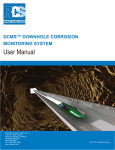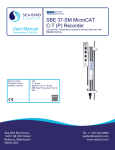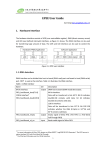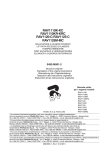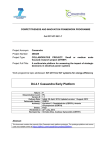Download Directed Electronics K10 Specifications
Transcript
Kuster Company 2900 E. 29th Street Long Beach, CA USA 90806 Telephone 562-595-0661 Fax 562-426-7897 E-Mail [email protected] KUSTER K10 ELECTRONIC GAUGES OPERATION MANUAL ____________________________________________________________________________ ATTENTION: K10 GAUGES BOTH STRAIN AND QUARTZ OF ALL SIZES: DURING ASSEMBLE/ DISASSEMBLE, WRENCHES ARE TO BE PLACED ON THE CLOSEST FLATS. NO PIPE WRENCHES ARE TO BE USED ON KUSTER MEMORY GAUGES. WISES WITH ROUND HALF CLAMPS ARE RECOMMENDED FOR FIXING THE GAUGES FOR DISASSEMBLE PROCEDURES. IN ORDER TO AVOID TOOL MALFUNCTIONING, O’RINGS UNDER THE ELECTRONICS HOUSING SHOULD BE REPLACED STRICTLY ACCORDING THE PROCEDURE, DESCRIBED AT THE END OF THIS MANUAL. WARNING: ALL ELECTRONIC GAUGES: UNDER NO CIRCUMSTANCES IS THE TEMPERATURE RATING OF THE BATTERIES TO BE EXCEEDED. WORK PREPARATION: 1. Make sure that the tool is able to meet the anticipated requirements of the well to be surveyed, i.e. pressure and temperature limitations. 2. Make sure that the battery temp limit meets the requirements of the well to be surveyed. 3. Check the battery voltage using the supplied battery tester. With the load adapter attached to the DMM and the battery turn the selector switch to 20 Vdc. Turn on DMM and read voltage. The load adapter has 380Ω resistor inside which emulates the board. The voltage of the battery under 380Ω load should be min 3.1 v for the AA type batter and min 6.1 v for C type. If the new battery has shown very low voltage, the problem could be in the battery being passivated. In order to depassivate the battery apply Lo and Hi loads of the tester. There is another way of checking the battery. Connect battery to the gauge. First you will get 1 long flash on battery LED. After that, six or less short flashes. Amount of the short flashes will indicate approximate voltage of battery. For example, if you will get 6 short flashes, it will indicate, that the battery voltage is about 3.6v, which is a maximum battery charge level. If it will flash 5 times, then the battery voltage is about 3.5v and so on. Flickering flash with assigned rate will indicate that gauge start sampling. At 1second sample rate you will not get a flickering flash, but a regular short one. Third method of checking the battery is with a help of the software and is explained in the software manual. 4. Power comm. box either with gauge battery or thru a wallwart. Connect gauge through interface-box to the computer. 5. You will get 1 long flash and then 4 short flashes on comm. box for strain gauge and 5 flashes for quartz. After that it will continue to flash in communication mode. If you don’t get right amount of flashes, tool and battery feasibility should be questioned. 6. Program the gauge with desired rate. (See software manual for a more detailed explanation of programming options). CAUTION: DO NOT DISCONNECT GAUGE DURING DATA TRANSMISSION. 7. Disconnect gauge from the interface box. 8. Apply a bead of Kuster hi-temp thread lube to all threads and across o’ring glands. 9. Disconnect the buffer tube assembly from transducer sub. 2 10. Drop some oil into the transducer sub until it’s full. Never insert syringe or any other device into the transducer port more than 1/8”, as damage to transducer may occur. 11. Using oil pump, fill buffer tube assembly with a light mineral oil. Don’t try too hard pushing the pump lever. Slow, but steady force until oil flows from the end of the tube, that’s all you need. 12. Install buffer tube assembly on the gauge. 13. Install tandem sub on the gauge with external RTD. If gauge does not have an external RTD, fill the tandem sub with oil, before installing it on the gauge. Wipe the tandem sub out and wrap a scotch tape over the hole. 14. Install bull nose. Now tool is ready and can be delivered to the well site. AFTER ARRIVAL: 1. Connect the battery and note date and time of connection 2. Install battery housing hand tight and finishing tightening with wrenches. Do not over torque. 3. Connect wireline socket. 4. If it is a gauge without external RTD, put gauge in vertical position and take the scotch tape off the tandem sub hole. 5. With the lubricator pressured up, allow the gauge at least 15 minutes within the lubricator, to stabilize before running in the hole. 6. If a static gradient is being run, allow at least ten minutes per stop to allow the gauge to stabilize and to provide for a sufficient number of samples to be recorded. Note: The tool should not be pulled in or out of the hole faster than 50 m/min. AFTER THE SURVEY: 1. Pull gauge out of the well. 2. Wash down exterior of tool and wipe dry. 3. Remove battery housing and disconnect the battery (note the time and date). 4. Disconnect tandem sub from the gauge. 5. Disconnect buffer tube assembly. 6. Wash down nose of tool, tandem sub and buffer tube assembly with solvent. 7. Flush transducer port with solvent using syringe and allow to drain. 8. Flush and fill buffer tube assembly with clean silicone oil and set aside. 3 9. Connect gauge through comm. box to the computer, wait for 4 (strain gauge), and 5 (quartz gauge) LED flashes on comm. box and download data to the hard drive (See software operational manual). CAUTION: DO NOT DISCONNECT GAUGE DURING DATA TRANSMISSION. 10. Remove old o’rings from I/O connector side of the gauge. 11. Wipe clean the threads and o’ring surfaces and inspect visually all threads for signs of damage, galling and etc. 12. Install two new o’rings under the battery housing, (C-ring for 1-1/5” K10 SS gauge). 13. Lube threads with Kuster high temp lube. 14. Program tool for 2 point DWT. 15. Install battery and battery housing. 16. Run 2 point DWT. 17. Download the data from the gauge. 18. Review, record & file 2 point DWT. 19. Fill transducer port with fresh oil and install buffer tube assembly onto it. 20. Install tandem sub and bull nose. DISASSEMBLE/ ASSEMBLE K10 STRAIN 1-1/4” AND K10 QUARTZ 1-1/4” GAUGES IN ORDER TO CHANGE O’RINGS UNDER THE ELECTRONIC HOUSING The frequency of changing o’rings under an electronic housing should be dependent on well fluid types, temperature and gauge usage intensity. With high content H2S we recommend changing these o’rings every 6 months or 1000 hours in well, which ever comes first. The frequency of changing o’rings under battery housing is up to the tool operator discretion. They should be replaced at the first evidences of wear. All Kuster electronic gauges are furnished with Parker Company Viton o’rings, which cover the majority of well fluids in the field, however the last decision on which type of o’rings to use is up to the operator of the gauge. A wrong choice could lead to tool malfunctioning and denial of warranty. Consult with the o’ring manufacturer, if you are not sure that these o’rings are suitable for your applications. It is mainly a concern for the well fluids with high content of H2S. Electronic housing disassembly: 1. Unscrew slotted nut from the top of the LEMO connector with a fork wrench, which comes with accessories. 2. Push connector just below the keyway cutout in the housing. 3. With the connector being below the keyway, carefully unscrew electronic housing from the pressure sub. 4. Remove old o’rings. 5. Check thread and o’ring grooves and lubricate them with Kuster lube grease. 4 6. Replace o’rings on the pressure sub and lube them. 7. Check connector’s o’ring and replace if necessary. Reassembly: 1. Extend telescopic clip through the keyway end of the housing. 2. Grab the connector with the clip. 3. Slide electronic board with connector through the housing, but keep connector below the keyway. 4. With connector below the keyway, screw electronic housing onto pressure sub and tighten it. 5. Pull connector through the keyway. 6. Slide slotted nut over the telescopic clip. 7. Slide fork wrench over the telescopic clip. 8. Screw the slotted nut onto the end of the connector and tighten it with a fork wrench. DISASSEMBLE/ ASSEMBLE K10 STRAIN 3/4” GAUGE IN ORDER TO CHANGE O’RINGS UNDER THE ELECTRONIC HOUSING AND BUFFER TUBE SUB 1. Fix gauge (transducer sub) in the wise with round clamps 2. Unscrew and pull out: LEMO connector to the length, which would allow you to unsolder the connector. 3. Unscrew and pull out electronic housing 4. Unsolder electronic board from the transducer 5. Unscrew buffer tube sub from transducer sub 6. Remove old o’rings and PEEK back-up rings 7. Check threads and o’ring grooves and lubricate them with Kuster lube grease. 8. Replace o’rings and PEEK back-up ring and lubricate them 9. Reconnect the transducer sub with the buffer tube sub (35 ft-lb torque). 10. Re-solder circuit board to the transducer wiring 11. Slide electronics housing over the circuit board and tighten up with 25 ft-lb torque. 12. Re-solder LEMO connector to the board wiring. 13. Screw LEMO connector back to the electronic housing, using small amount of locktite or similar compound to secure LEMO connector in the housing… DISASSEMBLE/ ASSEMBLE K10 QUARTZ 3/4”GAUGE IN ORDER TO CHANGE O’RINGS UNDER THE ELECTRONIC HOUSING AND BUFFER TUBE SUB. 1. Fix gauge (transducer sub) in the wise with round clamps. 2. Unscrew and pull out: LEMO connector to the length, which would allow you to unsolder the connector. 3. Unscrew and pull out electronic housing 4. Remove old o’rings and back-up ring 5. Check threads and o’ring grooves and lubricate them with Kuster lube grease. 6. Replace o’rings and back-up rings and lubricate them Assemble in the reverse order DISASSEMBLE/ ASSEMBLE K10 STRAIN 1”AND QUARTZ 1”GAUGE IN ORDER TO CHANGE O’RINGS UNDER THE ELECTRONIC HOUSING AND BUFFER TUBE SUB. 1. 2. 3. 4. 5. 6. Fix gauge (transducer sub) in the wise with round clamps Unscrew set 4 set screws to release LEMO. Pull out LEMO and collars from the housing. Unscrew and pull out electronic housing. Remove old o’rings and back-up rings Check threads and o’ring grooves and lubricate them with Kuster lube grease. 5 7. Replace o’rings and back-up rings and lubricate them Assemble in the reverse order. DISASSEMBLE/ASSEMBLE K10 QUARTZ 1.5” SOUR SERVICE GAUGE IN ORDER TO CHANGE O’RINGS AND METAL C-RING UNDER ELECTRONIC HOUSING. The frequency of changing O-rings and C-ring under the electronic housing should be dependent on well fluid types, temperature and gauge usage intensity. With high content H2S we recommend changing these O-rings every month or 80 hours in well, whichever comes first. But the final decision on Seals replacement frequency is have to be based on operator’s company policies and instructions. The frequency of changing O-rings and C-ring under battery housing is up to the tool operator discretion. They should be replaced at the first evidences of wear. All Kuster electronic gauges are furnished with Parker Company Viton O-rings, which cover the majority of well fluids in the field, however the last decision on which type of O-rings to use is up to the operator of the gauge. A wrong choice could lead to tool malfunctioning and denial of warranty. Consult with the O-rings manufacturer, if you are not sure that these O-rings are suitable for your applications. It is mainly a concern for the well fluids with high content of H2S. Electronic housing disassembly: 8. Unscrew slotted nut from the top of the LEMO connector with a fork wrench, which comes with accessories. 9. Push connector just below the keyway cutout in the housing. 10. With the connector being below the keyway, carefully unscrew electronic housing from the pressure sub. 11. Remove old O-rings and C-ring. 12. Check thread and O-rings grooves and lubricate them with Kuster lube grease. 13. Replace O-rings and C-ring on the pressure sub and lube them. 14. Check connector’s O-rings and replace if necessary. Reassembly: 9. Extend telescopic clip through the keyway end of the housing. 10. Grab the connector with the clip. 11. Slide electronic board with connector through the housing, but keep connector below the keyway. 12. With connector below the keyway, screw electronic housing onto pressure sub and tighten it until C-ring is crushed. 13. Pull connector through the keyway. 14. Slide slotted nut over the telescopic clip. 15. Slide fork wrench over the telescopic clip. 16. Screw the slotted nut onto the end of the connector and tighten it with a fork wrench. 6 7 8 9 10 11 12 13 BATTERY VOLTAGE AND USAGE Given the variety of tests and surveys that exist in the downhole environment, a definitive guideline for battery usage is impossible. The technician needs to use a certain amount of judgment on when to use or not to use a particular battery pack. The decision should be based on three things. 1. The length of the test (survey) to be run. 2. The amount of time a battery has been used. 3. The voltage the battery shows on the communication box. In order to measure battery’s charge level, connect battery to the comm. Box, which in its turn should be connected to the gauge and computer The circuit board electronics of both the strain and quartz gauges requires approximately 3 volts minimum to operate correctly. And the quartz transducer requires 6.5 volts minimum to operate correctly. Since lithium batteries maintain the maximum stated voltage for the useable life of the battery; once the voltage starts to drop their useable life is short indeed. For example: Our AA batteries are rated at 1.5Ah. But this number is taken after 80% of the life has been used. The remaining voltage is approximately 2.5volts. Not enough to operate the gauge properly. 1Ah leaves approximately 3-3.2volts left. Realistically the battery should not be used past 1Ah. Of course this is where the judgment of the operator comes into play. Also, do not forget that sometimes lithium batteries passivate (go to sleep) and need to be awakened. This can cause the voltage to be much lower than it really is. You can wake them up by shaken them up or using the battery load tester. In order to check battery voltage, insert the load tester with battery on it into the Multi-meter. Voltage, that you will see, is the voltage of the battery without any load. Push 100om button on the tester to imitate circuit board load and observe battery voltage. Recommendation: AA lithium- with 380 ohm load adapter- 3.1 volts.... Do not use. C lithium - with 380 ohm load adapter- 6.1 volts….Do not use. If you use batteries all the time, there is a little chance they’re going to passivate (read the Passivation of Lithium Cells chapter down-bellow). But if you think it’s happened, push 10om button on the Quartz load tester and 20om on Strain for wakening up them up. 14 LITHIUM OXYHALIDE PRIMARY CELLS Basic Handling Note: With the exception of QTC and PC cells, every Electrochem lithium battery is equipped with an internal safety fuse. These very fast acting fuse elements can be opened with even the slightest short circuit. Therefore, use care in handling these products to prevent any potential short circuit condition. If a cell fuse should open, do not attempt to repair it yourself. Contact Electrochem distributor for assistance. Safety Although every Electrochem lithium battery is designed and manufactured for safe operation, it is important to observe several key points: • • • • • • Never store or operate a battery above its designated maximum temperature. Never store cells of different chemistry, size, age, or discharge depth. Under no circumstances should the terminal cap of a cell be removed. Do not crush, puncture, or attempt to disassemble a cell or battery pack. Never use excessive force, or hammering to free batteries lodged inside any type of housing. Standard industrial safety practices, such as the wearing of eye protection, should always be employed when handling batteries or other high power energy devices. Shipping Electrochem lithium batteries are shipped in full compliance with all rules and regulations governing proper packaging as set forth by the United Nations and enforced by various international agencies. Whenever re-shipping lithium batteries, the customer must ensure that all methods used are in compliance with the latest regulations. Disposal The regulations concerning the disposal of lithium batteries vary widely. Local disposal regulations differ and subject to change. Contact the proper Environmental Agency in your area for questions regarding the disposal of lithium batteries. Specifications 3B1065 Series PMX150 (AA cells) Open circuit voltage at room temperature……………………………………………….…….3.9V Rated discharge current………………………………………………………………….…….20mA Rated capacity…………………………………………………………………………………..1.6 Ah Maximum continuous discharge current……………………………………………...…….150 mA Operating temperature range………………………………………………………..-40C to +150C -40F to +302F Weight………………………………………………………………………………………….…..15 g Safety fuse…………………………………………………………………………….…….....4 A link Lithium weight…………………………………………………………………………………….0.5 g This product is not restricted under DOT or IATA shipping regulations PASSIVATION OF LITHIUM CELLS Passivation is a phenomenon of liquid cathode lithium cells related to the interaction of the metallic lithium anode and the oxyhalide electrolyte. A thin passivation layer forms on the surface of the anode at the instant the electrolyte is introduced into the cell. This layer is important because it protects the anode from reaction while the cell is dormant – resulting in a long shelflife. 15 During low rate discharge (5-10 microamps/cm2), the lithium ions that allow the cell to operate can migrate through the passivation layer. As the rate of discharge increases (0.1-1.0 milliamp/cm2), so does the porosity of the passivation layer, allowing greater ion flow and higher power output. This change in the structure of the passivation layer is illustrated in the diagram below. Under normal conditions, the thin passivation layer does not degrade cell performance. When the layer grows too thick, however, discharge performance may be affected. The growth of the passivation layer is influenced greatly by storage conditions. Long storage periods and/or high storage temperatures will cause the passivation layer to grow thicker. A passivated cell may exhibit voltage delay, which is the time lag that occurs between the application of a load on the cell and the voltage response. As the passivation layer thickens, the voltage delay becomes more severe. Eventually though, the voltage of a passivated cell will rise to a level equivalent to the load voltage of an unpassivated cell. Adjusting storage conditions to reduce the likelihood of passivation is the best way to reduce voltage delay. However, there are several effective methods for dealing with excessive passivation when storage conditions cannot be controlled. The layer can be kept from growing too thick by maintaining a light load on the cell during storage. Alternatively, a higher load, placed on the cell at regular intervals during storage, or just prior to the anticipated start-up of the cell, can be used to disrupt the passivation layer and restore normal performance. Both of these methods will have an impact on the useable capacity of the cell. In particular, a low rate discharge tends to increase the normal self-discharge reaction of the cell and reduce the available capacity. . Electrochem utilizes additives in many of its cell chemistries (including CSC, PMX and MWD cells) to minimize passivation formation and enhance restart performance. Under most operating conditions, depassivation of an Electrochem cell is unnecessary. However, under some more severe conditions (such as high temperature storage) it may be beneficial to depassivate a cell. For the most effective depassivation, Electrochem generally recommends discharging a cell near the specified maximum continuous discharge rate. The table below shows the maximum discharge current and recommended depassivation load for several of the most widely used Electrochem cell models. Note that the load given in the table will yield close to the rated maximum continuous current for an individual cell. The load should be adjusted accordingly for multi-cell battery packs. A depassivation load should be applied until the cell voltage recovers to a normal level (> 3.0 volts). The recovery duration will depend on the severity of the passivation. Any questions regarding the performance of Electrochem cells should be directed to an Electrochem Sales or Customer Service representative, or to an authorized Electrochem dealer. Cell Type Part Number BCX AA BCX C BCX D BCX DD CSC AA CSC C CSC D CSC DD PMX AA PMX C PMX CC PMX DD VHT C MWD CC 3B0064 3B0070 3B0075 3B0076 3B0024 3B0030 3B0035 3B0036 3B1065 3B3700 3B3000 3B2800 3B4800 3B3200 Maximum Rated Discharge (mA) 100 500 1000 3000 150 1000 2000 4000 150 500 500 2000 250 1000 Depassivation Load (Single Cell) (ohm) 30 6 3 1 20 3 2 1 20 6 6 2 10 3 16




















